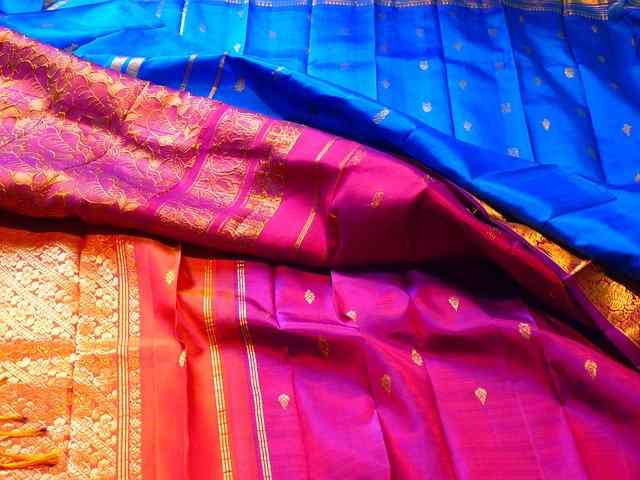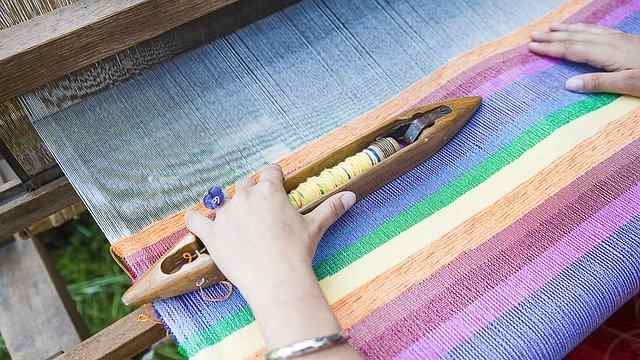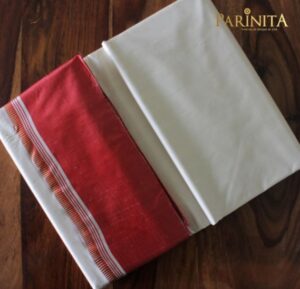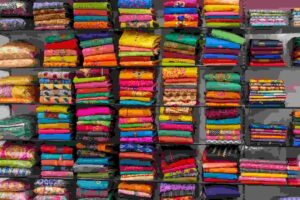The queen of all fabrics, silk was one of the most important industries of Bengal. Silk has long played a major role in the lifestyles of the Bengali upper classes. A silk sari is a symbol of elegance, sophisticated taste, traditional femininity, and cultural authenticity.

Silk was first discovered earliest in China, and from there, it spread to different parts of the world, including India. India is the only country that produces all four varieties of silks called Mulberry, Tasar, Muga, and Eri.
India is a major consumer of silk in the world. Women love to adorn themselves in fine quality silks during celebrations. India is the second-largest producer of silk.
Silk is produced from the cocoons of the larvae of the mulberry silkworm. This process is called sericulture. The yarns produced from this process are used to weave a variety of textiles.
Invention Of Silk In China
Around 7000 years ago, silk was first invented in China.
One day Chinese Empress Xi Ling Shi was sitting under a Mulberry tree and having a warm tea. A silk worm’s cocoon fell right into her cup. In its attempt to get out, the fiber of the cocoon began to unroll in the tea solution, and a white thread unraveled itself.

The emperor Huang Ti, also known as Yellow Emperor, encouraged his wife to study the life of silkworms.
The methods of silk processing remained a closely guarded secret in China for thousands of years.
This accidental discovery of silk became a great source of wealth for the Chinese empire.
Chinese silk traders went to distant lands to trade with the Roman empire. The route they followed was referred to as the Silk Route.
Around 2000 years ago, silk was the cloth of emperors and royalty. Gradually, people from different sections of society began wearing silk, and it came into more general use.
So, how the mystery of silk was unraveled. Tales suggest a Chinese princess married outside China. She took silkworm eggs and mulberry tree seeds in her traditional headdress. The historical text also suggests that about 2200 years ago, several people migrated from China and settled in Korea.
From then on, the knowledge of silk production slowly traveled throughout Asia and Europe.
History Of Silk In India
Silk first found mention in the Vedic literature, dating back to about 5000 BC. The discovery of silk pieces in the areas around the Indus Valley Civilization, the oldest civilization in the subcontinent, proves the silk production was also done in the areas since that time.
Silk was introduced in India through Persia, the two countries trading in the textile. India obtained much of the luxurious designs and weaving techniques from Persia.
During the medieval period, high-quality silk production was greatly patronized under Mughal’s Rule in India.
The ancient centers of silk were situated mainly in Malwa, Gujarat, and South India.
Silk weaving subsequently became popular around those areas where kingdoms and holy cities were located.
Rise Of Bengal Silk
In the 16th century, commercial production of silk started in Bengal during the reign of Sultan Hussain Shah.
In the seventeenth century during the Mughal period, Bengal was a major hub of silk trading in India. The foreign merchants got attracted to authentic Bengal silk.
Murshidabad, the seat of power of the Nawabs of Bengal, was a well-known hub for silk textiles.

The fertile soil of Murshidabad was conducive to the growth of mulberry plants. Cossimbazar was the beating heart of this artisanal industry. British silk merchants used to purchase silk from here.
Those days, luxurious and expensive silk fabrics were even traded between Indian royal families as gifts.
In the later seventeenth century, the East India Company, the Dutch, the French, and the Portugees had also started purchasing silk fabrics from Bengal. The silk industry of Bengal soon began to develop with European capital and organization.
The East India Company introduced a new variety of silkworm breeds and mulberry in Bengal. The company made constant efforts to promote sericulture and extend the trade in silk.
At one point, the cheaper Bengal silk drove out all competitors out of the European market.
Tipu Sultan, the ruler of the Kingdom of Mysore, first initiated the silk industry in Mysore. In 1785, he sent his people to learn sericulture from Bengal. Today, Karnataka is the largest producer of raw silk in India.
Decline Of Bengal Silk
British revealed their true character after the Battle of Plassey (1757). The company monopolized the business of Bengal silk by forcing the weavers to sell their products only to them at less price. The weavers of Bengal were paid far less than the market price and were forced to work in the factories in inhuman conditions. Unable to withstand the oppressive measures, many weavers left their profession.
The industry went into further decline as the industrial revolution in the west set in. With the uprising of Manchester Silk, the company changed its policies in India and discouraged the manufacture of silk in Bengal.
At last, in 1833, the East India Company decided to shut down the silk trade leading to total unemployment of the silk spinners. The weavers and artisans involved with the Bengal silk industry faced a significant crisis. Further, the epidemic of silkworm diseases and technological stagnation led to the closing of hundreds of filatures and silk handlooms.
In the early 20th century, Bengal lost most of its foreign markets. Kashmir and Mysore silk captured the South Asian markets. By the 1930s, in Bengal itself, Chinese and Japanese silk replaced the local silk products.
Despite all these issues, the artisanal silk industry of Bengal survived.
The popular policies adopted at the dawn of Independence in India were beneficial for the Bengal silk industry, to expand employment and income opportunities in the rural economy.
However, in the last few decades, there is a large exodus of silk farmers and weavers from the industry.
Due to organizational problems, administrative reasons, and physical conditions like climate change, which would often lead to drought and flood, the production of mulberry has declined.
The cheap silk yarn from China has flooded the Indian markets.
That has negatively affected the production of silk locally. The demand for local silk has reduced due to the import of China silk.
Sericulture in West Bengal is concentrated in the districts of Malda, Murshidabad, and Birbhum. Malda produces 75% of the state’s production of mulberry-raw silk in West Bengal.
Murshidabad is the second-largest traditional silk-producing district in West Bengal. Murshidabad silk sarees have a demand both inside and outside of Bengal.









[…] a conflict. In Europe, good quality cotton and silk manufactured in India had a large market. The silk industry of Bengal developed with the European capital. Spices such as cinnamon, cardamom, cloves, and pepper were […]